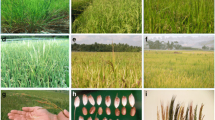Abstract
Reed canary grass is a widely adapted temperate grass with a circumglobal distribution in the northern hemisphere. Because it has relatively high biomass yields under relatively infrequent harvest systems, this species is receiving increasing attention as a bioenergy feedstock. The objective of this study was to conduct a comparative biomass yield evaluation of reed canary grass accessions from a wide range of habitats in the north central and northeastern USA. Eight cultivars and 72 accessions were evaluated for biomass yield over 2 years at five locations in Iowa, New York, and Wisconsin. Accessions produced, on average, 6.7% higher biomass yield than the cultivars. Cultivars ranked from 50th to 77th in biomass yield out of a total of 80 cultivars and accessions. Genetic expression for biomass yield was highly consistent across locations and years. Accessions from southern and western collection sites tended to have the highest biomass yield. Reed canary grass populations in rural landscapes of the central and northeastern USA have value for increasing biomass yield potential of this bioenergy feedstock candidate species. The high biomass yield of many of these populations, combined with the large amount of genetic variability among these populations, offers potential for both short-term gains by selecting superior accessions and long-term gains by selection and breeding.



Similar content being viewed by others
References
Association of Official Seed Analyses (1998) Rules for seed testing. AOSA, Beltsville
Barker RE, Hovin AW, Carlson IT, Drolsom PN, Sleper DA, Ross JG et al (1981) Genotype-environment interactions for forage yield of reed canarygrass clones. Crop Sci 21:567–571
Carlson IT, Oram RN, Surprenant J (1996) Reed canarygrass and other Phalaris species. In: Moser LE et al (eds) Cool-season forage grasses. ASA-CSSA-SSSA, Madison, pp 569–604
Casler MD (1999) Spatial variation affects precision of perennial cool-season forage grass trials. Agron J 91:75–81
Casler MD (2009) Genetics, breeding, and ecology of reed canarygrass. Intl J Plant Breeding (in press)
Casler MD, Phillips MM, Krohn AL (2009) DNA polymorphisms reveal geographic races of reed canarygrass. Crop Sci. (in press)
Charles AH (1961) Differential survival of cultivars of Lolium, Dactylis, and Phleum. J Brit Grassl Soc 16:69–75
Cherney JH, Cherney DJR, Casler MD (2003) Low-intensity harvest management of reed canarygrass. Agron J 95:627–634
Christian DG, Yates NE, Riche AB (2006) The effect of harvest date on the yield and mineral content of Phalaris arundinacea L. (reed canary grass) genotypes screened for their potential as energy crops in southern England. J Sci Food Agric 86:1181–1188
Jasinskas A, Zaltauskas A, Kryzeviciene A (2008) The investigation of growing and using of tall perennial grasses as energy crops. Biomass Bioenergy 32:981–987
Lavergne S, Molofsky J (2007) Increased genetic variation and evolutionary potential drive the success of an invasive grass. Proc Natl Acad Sci USA 104:3883–3888
Lindvall E (1997) Breeding reed canarygrass as an energy or fibre crop by using local collected wild populations. In: Buchannan-Smith JG et al (eds) Proc. XVIII Intl. Grassl. Congr. Saskatoon, Sask., Canada Extension Service, pp 31-32
Linhart YB, Grant MB (1996) Evolutionary significance of local genetic differentiation in plants. Ann Rev Ecol Syst 27:237–277
Marten GC, Clapp CE, Larson WE (1979) Effects of municipal wastewater effluent and cutting management on persistence and yield of eight pernnial forages. Agron J 71:650–658
Marten GC, Hovin AW (1980) Harvest schedule, persistence, yield, and quality interactions among four perennial grasses. Agron J 72:378–387
Merigliano ME, Lesica P (1998) The native status of reed canarygrass (Phalaris arundinacea L.) in the inland Northwest, USA. Natural Areas J 18:223–230
Pahkala K, Aalto M, Isolahti M, Poikola J, Jauhiainen L (2008) Large-scale energy grass farming for power plants—a case study from Ostrobothnia, Finland. Biomass Bioenergy 32:1009–1015
Sachs APW, Coulman BE (1983) Variability in reed canarygrass collections from Eastern Canada. Crop Sci 23:1041–1044
Sahramaa M (2003) Evaluation of reed canary grass for different end-uses and in breeding. Agric Food Sci Finland 12:227–241
Sahramaa M, Ihamäki H, Jauhiainen L (2003) Variation in biomass related variables of reed canary grass. Agric Food Sci Finland 12:213–225
Sheaffer CC, Marten GC (1995) Reed canarygrass. In: Barnes RF, Miller DA, Nelson CJ (eds) Forages volume I. An introduction to grassland agriculture. Iowa State University Press, Ames, pp 335–343
Smith KF, Casler MD (2004) The use of spatially adjusted herbage yields during the analysis of perennial forage grass trials across locations. Crop Sci 44:56–62
Snaydon RW (1978) Genetic changes in pasture populations. In: Wilson JR (ed) Plant relations in pastures. CSIRO, East Melbourne, pp 253–269
Steel RGC, Torrie JH, Dickey DA (1997) Principles and procedures of statistics. A biometrical approach, 3rd edn. McGraw-Hill, New York, p 666
Wrobel C, Coulman BE, Smith DL (2009) The potential use of reed canarygrass (Phalaris arundinacea L.) as a biofuel crop. Acta Agric Scand Section B 59:1–18
Acknowledgments
We thank Mike Barker and Sam Beer for assistance in collecting reed canary grass accessions. We also thank Mark Smith, Nick Baker, and Sam Beer for assistance with harvesting and maintaining reed canary grass plots.
Author information
Authors and Affiliations
Corresponding author
Rights and permissions
About this article
Cite this article
Casler, M.D., Cherney, J.H. & Brummer, E.C. Biomass Yield of Naturalized Populations and Cultivars of Reed Canary Grass. Bioenerg. Res. 2, 165–173 (2009). https://doi.org/10.1007/s12155-009-9043-0
Published:
Issue Date:
DOI: https://doi.org/10.1007/s12155-009-9043-0




